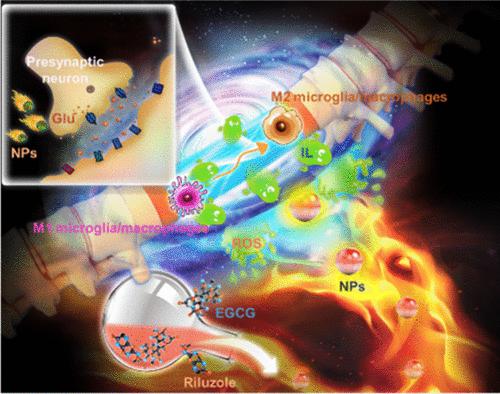当前位置:
X-MOL 学术
›
Biomacromolecules
›
论文详情
Our official English website, www.x-mol.net, welcomes your feedback! (Note: you will need to create a separate account there.)
Functional Polyphenol-Based Nanoparticles Boosted the Neuroprotective Effect of Riluzole for Acute Spinal Cord Injury
Biomacromolecules ( IF 6.2 ) Pub Date : 2024-03-26 , DOI: 10.1021/acs.biomac.4c00173 Taoyang Yuan 1 , Tianyou Wang 2 , Jianhua Zhang 2 , Feng Ye 1 , Zhipeng Gu 2 , Yiwen Li 2 , Jianguo Xu 1
Biomacromolecules ( IF 6.2 ) Pub Date : 2024-03-26 , DOI: 10.1021/acs.biomac.4c00173 Taoyang Yuan 1 , Tianyou Wang 2 , Jianhua Zhang 2 , Feng Ye 1 , Zhipeng Gu 2 , Yiwen Li 2 , Jianguo Xu 1
Affiliation

|
Riluzole is commonly used as a neuroprotective agent for treating traumatic spinal cord injury (SCI), which works by blocking the influx of sodium and calcium ions and reducing glutamate activity. However, its clinical application is limited because of its poor solubility, short half-life, potential organ toxicity, and insufficient bioabilities toward upregulated inflammation and oxidative stress levels. To address this issue, epigallocatechin gallate (EGCG), a natural polyphenol, was employed to fabricate nanoparticles (NPs) with riluzole to enhance the neuroprotective effects. The resulting NPs demonstrated good biocompatibility, excellent antioxidative properties, and promising regulation effects from the M1 to M2 macrophages. Furthermore, an in vivo SCI model was successfully established, and NPs could be obviously aggregated at the SCI site. More interestingly, excellent neuroprotective properties of NPs through regulating the levels of oxidative stress, inflammation, and ion channels could be fully demonstrated in vivo by RNA sequencing and sophisticated biochemistry evaluations. Together, the work provided new opportunities toward the design and fabrication of robust and multifunctional NPs for oxidative stress and inflammation-related diseases via biological integration of natural polyphenols and small-molecule drugs.
中文翻译:

功能性多酚纳米颗粒增强利鲁唑对急性脊髓损伤的神经保护作用
利鲁唑通常用作治疗创伤性脊髓损伤 (SCI) 的神经保护剂,其作用是阻止钠离子和钙离子的流入并降低谷氨酸活性。然而,由于其溶解性差、半衰期短、潜在的器官毒性以及上调炎症和氧化应激水平的生物能力不足,其临床应用受到限制。为了解决这个问题,采用天然多酚表没食子儿茶素没食子酸酯(EGCG)与利鲁唑一起制造纳米颗粒(NP),以增强神经保护作用。由此产生的纳米颗粒表现出良好的生物相容性、优异的抗氧化特性以及对 M1 至 M2 巨噬细胞的良好调节作用。此外,成功建立了体内SCI模型,纳米粒子在SCI部位可以明显聚集。更有趣的是,通过 RNA 测序和复杂的生化评估,可以在体内充分证明纳米颗粒通过调节氧化应激、炎症和离子通道水平而具有出色的神经保护特性。总之,这项工作通过天然多酚和小分子药物的生物整合,为设计和制造用于氧化应激和炎症相关疾病的强大的多功能纳米粒子提供了新的机会。
更新日期:2024-03-26
中文翻译:

功能性多酚纳米颗粒增强利鲁唑对急性脊髓损伤的神经保护作用
利鲁唑通常用作治疗创伤性脊髓损伤 (SCI) 的神经保护剂,其作用是阻止钠离子和钙离子的流入并降低谷氨酸活性。然而,由于其溶解性差、半衰期短、潜在的器官毒性以及上调炎症和氧化应激水平的生物能力不足,其临床应用受到限制。为了解决这个问题,采用天然多酚表没食子儿茶素没食子酸酯(EGCG)与利鲁唑一起制造纳米颗粒(NP),以增强神经保护作用。由此产生的纳米颗粒表现出良好的生物相容性、优异的抗氧化特性以及对 M1 至 M2 巨噬细胞的良好调节作用。此外,成功建立了体内SCI模型,纳米粒子在SCI部位可以明显聚集。更有趣的是,通过 RNA 测序和复杂的生化评估,可以在体内充分证明纳米颗粒通过调节氧化应激、炎症和离子通道水平而具有出色的神经保护特性。总之,这项工作通过天然多酚和小分子药物的生物整合,为设计和制造用于氧化应激和炎症相关疾病的强大的多功能纳米粒子提供了新的机会。



























 京公网安备 11010802027423号
京公网安备 11010802027423号